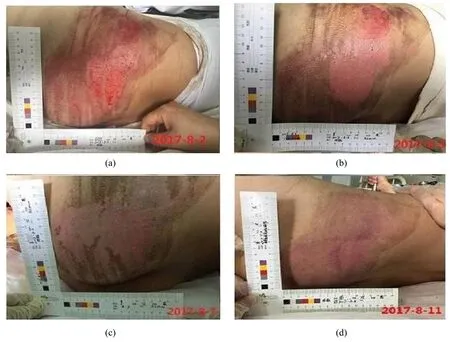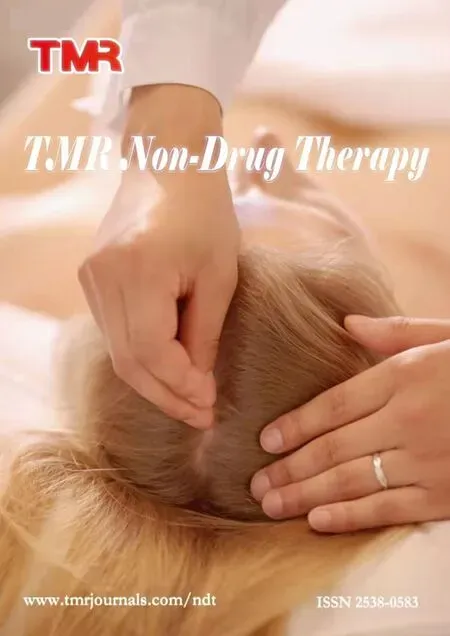Care for a patient with hip trauma caused by a car accident:a case study
Hong Chen,Jing He,Xing-Tong Bao
1Second Breast Surgery Department,Dongfang Hospital Beijing University of Chinese Medicine,Beijing 100078,China.2School of Nursing,Beijing University of Chinese Medicine,Beijing 100029,China.
Abstract Objective:To summarize the wound care experience of a patient with hip trauma caused by a car accident.Methods:Under the guidance of the“TIME”principle,we uesd new dressings to treat contaminated wounds and observed,record the effect.Results:The initial dressing change for the pressure ulcer wound was on 2nd August,the red tissue was on the wound,and the wound area was about 16 cm×20 cm.We changed the dressing on 11th August,the color of the wound turned to pink,its area was about 13 cm×13 cm,and it was already healed at that time.Conclusion:Under the guidance of the“TIME”principle of wound management,the treatment of contaminated wounds with new dressing treatment was effective,which reduced the patient’s pain and improved the patient’s quality of life.
Keywords:Trauma,“TIME”principle,Dressing,Case study
Background
In the process of production and activities,there are many factors that may cause damage to different parts of human body,of which car accidents are one of the most common causes.Wounds caused by car accidents are not infectious wounds,they should clinically treated with sterile operation and effective drug treatment,in order to avoid infection,to reach the first stage of healing.A case of hip trauma caused by a car accident is reported,its a well-recovered case treated with a new dressing under the guidance of the“TIME”principle of wound management to guide future clinical work.
Case introduction
The patient was hit by a car at 17:00 on July 30,2017,with no chest tightness,shortness of breath,loss of consciousness,self-call for help,emergency medical attention.He had no abdominal pain bloating,no fever,no coma,emergency treatment Rehydration to improve the relevant examination,to“abdominal cleavage,multiple skin soft tissue bruising,abdominal closure injury,bone fracture,sci-fi fracture”income general surgery,since the onset of the disease,the patient’s spirit is still normal,urinating once,no stool.She got abdominal invasive succulation in the emergency department,the procedure was smooth,the vital signs are stable,after surgery transferred to the surgical intensive care department observation and treatment,the condition is stabl.He was transferred to general surgery to continue treatment on August 2,2017.Diagnosis:(1)abdominal trauma,(2)abdominal wall open injury,(3)vaginal open injury,(4)multiple skin soft tissue bruises throughout the body,(5)bone fracture,(6)semen fracture,(7)7ththoracic compression fracture.
Method
Nursing assessment
Body assessment.When the patient was transferred,his spirit was normal,and his expression was just fine,his body cooperates,the whole body has many bruises,the right abdomen visible range of about 20×15 cm skin bruises,the right groin area and the right hip visible range of about 10×10 cm,15×12 cm of skin bruising,local swelling swelling,bruising,skin mucous membranes without yellowing,no rash,sub-skin nodules,scars,ulcers,hair distribution is normal,the body’s shallow lymph nodes are not swollen,the skull was deformed,press pain,clumps,no eyelid edema,conjunctivation is normal,the sclea is not yellowed,pupils and other large circles,normal reflection of light,no abnormal secretions in the outer ear channel,no cyanosis in the lips,normal gums and oral mucosa.There is no deformity in his chest profile and no varicose veins on the chest wall.Breathing movement is normal,rib gap is normal,speech tremor is normal.Diagnosis of clear tone,breathing regulation,double lung breathing sound clear,unheard and dry and wet tone,no pleural friction sound.The vital signs are body temperature of 38.0oC,pulse 100 times/min,breathing 20 times/min,blood pressure 120/77 mmHg.In the past,he denied the history of drug and food allergies.He has no bad habits,no smoking,no drinking.Laboratory tests informed:7.15 mmol/L on an empty stomach;white blood cells 9.97×109/L;hemoglobin 81 g/L;albumin 27.9 g/L;C-reactive protein 23.26 mg/L.Auxiliary examination of thoracic pelvic X-rays show:about T7 vertebrae slightly flattened,not except compression fractures,lumbar vertebrae did not see clear abnormalities,double-sided fissions did not see fractures.The upper and lower parts of his right cheekbone were fractured,and the siosis on both sides was fractured.
Psychological assessment.The patient’s family condition is fine,family relations are harmonious.They can actively cooperate with treatment.However due to the car accident trauma,he got hurt and felt pain.So he got some emotional tension,and he was anxiety.
Local assessment.The patient’s left hip wound was about 16×20 cm at that time,the wound was cover by red tissue 100%,the wound shape is irregular,and there was a small amount of seepage,no odor,surrounding the red skin.The pain score(Numerical Rating Scale)was 4 points.Considered there was a wide range of adults with high sensitivity and specificity,we chose the Braden pressure sore prediction scale recommended by the U.S.guidelines for the prevention of pressure sores for local assessment[1]:the total score is greater than or equal to 18 points,indicating that the patient is at risk of developing pressure sores,recommended preventive measures(sensitivity 50% to 60%);13 to 14 to medium risk(sensitivity 65% to 90%),less than or equal to 12 to high risk(sensitivity 90%to 100%),this example is assessed as 13 points(moderate risk).
Wound treatment
When the patient was transferred on August 2nd,his left hip wound was given 0.9% physiological saline cleaning;his inner dressing was covered with sulfonamide silver water colloidal yarn dressing to fight infection,and the outer layer was fixed with silicone viscose foam dressing(side shape)to maintain the moisture-absorbing environment and reduce pressure protection.Dressing change time:3 days.On August 3rd,the exudation on the foam dressing was observed again,so the wound dressing was changed.The wound area was about 13cm×17cm,the wound was 100% covered with red tissue,and there was no peculiar smell.The pain score was 3,and the redness and swelling of the surrounding skin was less than before.Before dressing change,the amount of exudate on the outer dressing was firstly observed.The patient’s wound exudate was moderate,and 0.9%normal saline was still given to clean and dry the wound.The inner dressing was treated with Bairtane silver ion alginate to absorb the exudate and provide anti-infection treatment,and the outer dressing was fixed with silicone adhesive foam dressing(with side shape).Dressing change time:3–5 days.On 7thAug we observed the non osmotic fluid on the foam dressing,gave him wound dressing change,the wound area was about 13×13 cm,and was covered with pink tissue 100%,it had no smell,his pain score was 0 points,the surrounding skin seemed normal.The amount of exudate on the outer layer dressing was first observed before dressing change,the wound was free of exudate,still given 0.9% normal saline to wash and dry the wound,the outer layer dressing was fixed with silicone adhesive foam dressing(edge-shaped),and treated under reduced pressure.Dressing change time:5 days.On August 11thwe changed the dressing,the wound area was about 13×13cm,the wound bed was covered with pink tissue totally,it has no smell,with no oozing fluid,the pain score was 0 points,surrounding with normal skin.We still used the new method for dressing change,and foaming dressing decompression treatment after that.Time of dressing change:5 days.
Evaluation of effects
The initial dressing change for the pressure ulcer wound on 2ndAugust,the wound was covered with red tissue,the wound area was about 16×20 cm,at the dressing changed on 11thAugust,the wound pink tissue,the wound area was about 13×13 cm,the wound was healed(see Figure 1 for the wound recovery process).No urinary infection,pulmonary infection and other complications occurred,and the patient’s anxiety was reduced.

Figure 1 Wound recovery process.(a)wound assessment before treatment;(b)wound assessment on the first day of treatment;(c)wound assessment on the fifth day of treatment;(d)the wound healed on the ninth day of treatment.
Nursing measures
Close observation of the wound situation
Each dressing change was compared with the last dressing change:the size of the wound,exudate,tissue type,odor,pain and other conditions are comprehensively evaluated,whether the inflammatory reaction of the surrounding tissues has improved or not,to judge whether the treatment plan is reasonable,according to the actual situation of the wound,take targeted measures,and choose the correct dressing,while constantly during the implementation process Feedback was again assessed and collected,and wound size and each dressing change and dressing used were recorded with a wound caliper and camera for revision of the treatment regimen.The dressings were selected according to the different periods and circumstances of the wound.Silver alginate dressings or foam based dressings were used in the inflammatory reaction period,and antimicrobial dressings were used in infected wounds[2].Dressing change time was defined according to the situation of wound exudate,pay attention to the proper method of sticking the dressing.
Decompression care
We maintained the cushion bed in the left and right 30 degree lateral or supine position,use a support surface,and roll over every 2 hours.
Improvement of nutritional status
Pay attention to his diet,paired reasonably,guarantee the intake of protein and vitamins,and eat more vegetables and fruits.
Medication
Intravenous cefoperazone sulbactam sodium 3G bid,ornidazole 0.5 g bid,ambroxol hydrochloride injection 30 mg bid;enteral nutrition emulsion(tpf-d)1000 mL.
Psychological nursing
Psychological nursing was used throughout the rescue and treatment process,the occurrence of car accidents is highest,and this patient without systematic preparation often shows alarmed and fearful of 10,000.In the treatment process,medical and nursing staff should pay more attention not only to the“acute disease”,but also to the“acute mood”[3].Medical and nursing staff give timely psychological comfort and estrangement in clinical care,so that patients understand their condition and eliminate their psychological state of tension,dazed pessimism.This patient had a better economic condition and a harmonic family relationship,although some nervousness and anxiety in the emotions,we should be patient listening to the patient’s needs,understand the patient’s psychological dynamics,and inform that their poor psychological mood will affect wound healing,at the same time,communicate with the patient’s family,and collectively encourage the patient to actively cooperate with treatment.
Health education
Keep the bed unit neat and use a cushion.Turn over every 2 hours,using an r-roll over pillow,and ensure proper turn over angulation.Instruct the family to proper turn over and avoid maneuvers such as drag and drag to reduce local pressure and friction,while monitoring the skin at other sites.The family members were instructed to observe the skin condition,especially the compressed skin at the bony process.We cleaned the patient’s skin everyday to keep the skin dry and refreshed if there is moisture irritation,and clean and replace it promptly.At the same time,the patient’s family members were instructed to observe whether there was curling and falling off phenomenon of the wound dressing.
Nursing experience
Wound ofenrefers to the destruction of skin tissue due to some cause,is prone to complications such as infection and severe sepsis[4].Proper application of wound bed preparation can create an environment for optimal wound healing.To produce a nutrient rich,minimally oozing fluid and infected wound bed,to enhance the growth of healthy granulation and finally to promote wound healing[5].“T(tiseue nonviable)means the evaluation of wound tissue and tissue necrosis,and management of tissue defects.I(infection/inflammation) remind healthcare professionals to control the wound infection or inflammation.M(moisture)is to maintain the moist balance of the wound.E(edge)is the process of promoting the epithelialization of wound edges.”The proposal of wound management principles provides a newapproach for wound caringpreparation for clinical applications characterizations of tissue infections,fluids and so on.As well as the selection of treatment options,it can provide more scientific guidelines and are a way to improve the outcome of treatment,allowing wounds to heal in a normal environment.
Conclusion
The nursing and therapeutic process of hip trauma patients caused by car accidents in this case suggests that our future work should focus on the following link.(1)Correct assessment is veryimportantfor promoting wound healing.(2)We need to select dressings reasonably according to the appearance of the wound and the situation of patients in order to achieve the best results.(3)The assessment and care of the wound pain of patients is also very improtant for the comparing between the traditional approach and a new one.(4)We should always adhere to the principles of bacteria free technical operation and“TIME”in the process of wound treatment.(5)We need to familiar with the performance of all types of wound products and constantly invasive[6].The inadequacy is the lack of post follow-up cases due to the limitation of the time of study practice.
- TMR Non-Drug Therapy的其它文章
- Research progress on non-drug treatment of diabetic kidney disease
- Research status of peri-menopausal insomnia based on bibliometrics
- Acupuncture of different stimulation for the treatment of neck type cervical spondylosis:a randomised controlled trial
- Application progress of acupuncture in treatment of ovarian hypofunction
- Nursing care of a patient with acute mastitis after dystocia

